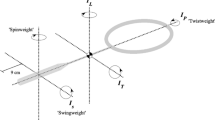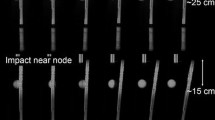Abstract
The kinematics of a badminton racket during a smash stroke was observed in this study with the purpose of investigating stroke dynamics and racket behaviour. Motion capture measurements of the racket during several smash strokes performed by three players of different skill levels indicated a clear increase in racket velocity at impact with increasing skill level. Variations between translational and rotational contributions to the impact speed could also be seen between the players. The advanced player produced a much higher peak angular velocity and also relied much less on translation, with a translational velocity of only 8% of the total velocity versus the 20% for the recreational player. It is proposed that, as an alternative to shuttlecock speeds, racket head speed measurements can be used as an indicator of performance, and can also provide some insight into the interaction between the racket and player.







Similar content being viewed by others
References
Tsai CL, Chang SS (1998) Biomechanical analysis of differences in the badminton smash and jump smash between Taiwan elite and collegiate players. In: Riehle HJ, Vieten MM (eds) Proceedings of the XVI International Symposium on Biomechanics in Sport. ISBS, Konstanz, pp 259–262
Hsieh CC, Wong TL, Wang JC, Chung MJ (2004) The effect of two different weighted badminton rackets about velocity and torque when outstanding badminton players was performing smash movement. In: Lamontagne M, Gordon D, Robertson E, Sveistrup H (eds) Proceedings of the XXII International Symposium on Biomechanics in Sport. ISBS, Ottawa, pp 462–464
Lee BK (1993) The effects of the kinematic link principle on performance. In: Hamill J, Derrick TR, Elliott EH (eds) Proceedings of the XI International Symposium on Biomechanics in Sport. ISBS, Amherst, Mass, pp 239–242
Liu X, Kim W, Tan J (2002) An analysis of the biomechanics of arm movement during a badminton smash. Nanyang Technological University, Singapore. http://www3.ntu.edu.sg/home5/pg02259480/badminton_smash.pdf. Accessed 5 May 2009
Rambely AS, Osman NAA, Usman J, Abas WABW (2005) The contribution of upper limb joints in the development of racket velocity in the badminton smash. In: Wang Q (ed) Proceedings of the XXIII International Symposium on Biomechanics in Sport. ISBS, Beijing, pp 422–426
Andersen MS, Damsgaard M, Rasmussen J (2009) Kinematic analysis of over-determinate biomechanical systems. Comput Methods Biomech Biomed Engin 12:371–384
Acknowledgments
We would like to acknowledge FZ Forza of Active Sportswear International, A/S for funding this project, and we would like to thank the Sports Biomechanics Lab at the National Taiwan Sport University for the generous use of their equipment.
Author information
Authors and Affiliations
Corresponding author
Rights and permissions
About this article
Cite this article
Kwan, M., Andersen, M.S., Cheng, CL. et al. Investigation of high-speed badminton racket kinematics by motion capture. Sports Eng 13, 57–63 (2011). https://doi.org/10.1007/s12283-010-0053-0
Published:
Issue Date:
DOI: https://doi.org/10.1007/s12283-010-0053-0




